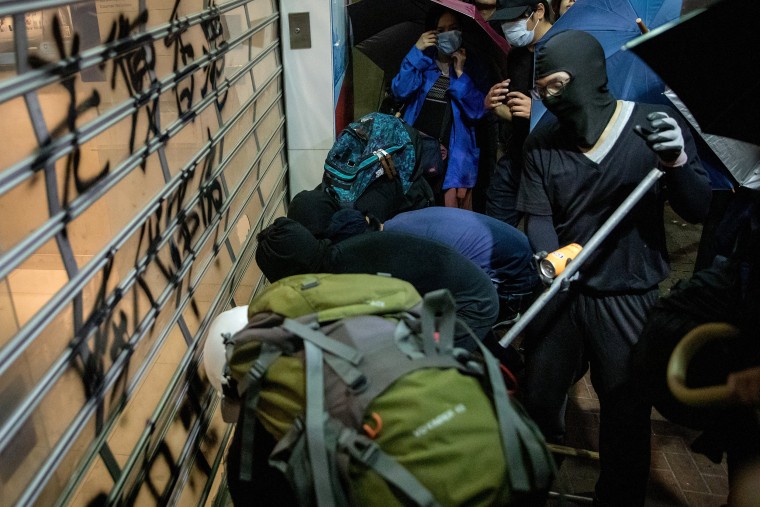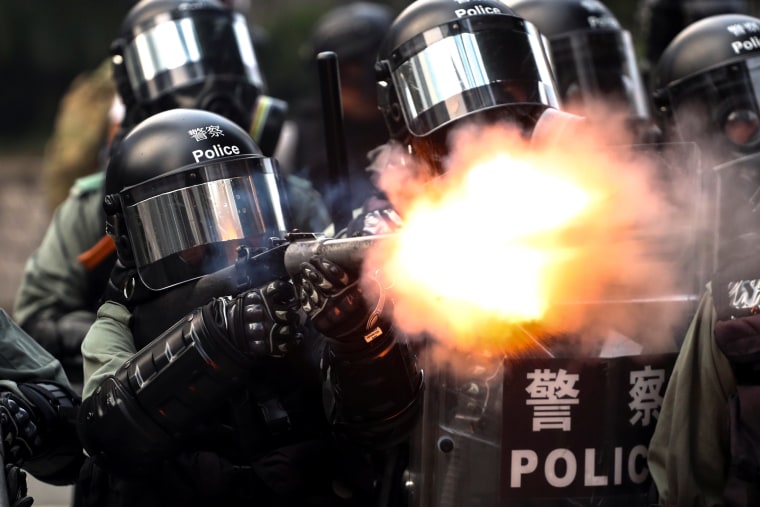A tragedy appears ever more imminent in Hong Kong.
As anti-government, anti-Beijing protests continue into their 17th week, clashes between law enforcement and protesters have become increasingly ugly and more violent. On Tuesday, as Beijing celebrated the 70th anniversary of the founding of the People’s Republic of China, an 18-year-old protester in Hong Kong was shot in the chest with a live round by the police.
It has become commonplace for the radical elements of the city’s democracy movement — namely, young protestors — to do battle with the more powerful police force.
It has become commonplace for the radical elements of the city’s democracy movement — namely, young protesters — to do battle with the more powerful police force. Weekend after weekend, violence rages on. Unless something changes, it is only a matter of time before a real tragedy involving fatalities occurs. Further escalation in violence could also lead to a much more severe crackdown by the Hong Kong government or a military intervention by Beijing, making the achievement of the movement’s goals all the more difficult.
The young protesters have resorted to violence because they believe it to be effective and necessary in their fight against Beijing’s encroachment upon their city’s autonomy under the “one country, two systems” system, the Hong Kong government’s ineptitude in safeguarding their rights or offering hope for their future, and the rampant police brutality that has come bearing down on their movement.
Numerous marches, rallies, protests and sing-alongs — numbering hundreds of thousands, and at times millions — have been peaceful, touching and inspirational. They have also reflected the frustrations common among broad segments of Hong Kong’s population.
Yet, peaceful protests on their own did not win concessions from Beijing. In July, when violence broke out and protesters stormed the Legislative Council, Hong Kong’s parliament, the movement saw concrete results. The city’s chief executive declared dead the controversial proposed extradition bill that had set off the protests. As violence escalated, she ultimately withdrew the bill. The protesters noticed and so did democracy activists who have historically advocated for nonviolent civil disobedience.
The excessive use of force by the police has been a rallying cry for protesters as well, and has galvanized support for the movement across Hong Kong society. Online videos and news reporting show the police severely beating nonresisting protesters, making arbitrary arrests and attacking innocent passersby, firing rubber bullets at point blank distance and in one instance, allegedly standing by while pro-Beijing gang members wantonly attacked protesters and bystanders at a train station.
The youngsters on the front lines, clad in black and wearing gas or face masks, cannot match the police’s weapons or lethal power, so they have responded by actively engaging in arson, vandalism, road blockades, brick and petrol-bomb throwing and destruction of public property. Their resistance is not sporadic, but systematic and organized.
The protesters’ trashing of Hong Kong’s metro stations has now become routine. About half of the city’s 91 stations have been damaged. On Oct. 1 alone, China’s National Day, 20 stations were subject to vandalism and arson. The entrances of prominent stations such as Central and Wanchai (think Times Square and Grand Central) were set aflame.

Road blockades and flash mobs throughout the city have also become a key tactic. One protester explained, “The point is to divide the police’s resources.” Another added, “We want our protesters to hit all 18 Hong Kong districts so the police need to stand by in all districts.”
Violence begets more violence. After four months of protests, both sides — police and protesters — have dug in. The police force, until recently known as “Asia’s finest,” have plenty of their own grievances, and see the protesters as thugs, hooligans, rioters and terrorists. Violent clashes have left them bloodied and on edge. In July, one officer had part of his finger bitten off by a protester. On China’s National Day, the most violent day of protests, multiple officers were injured with a corrosive liquid, with one incurring third-degree burns. Meanwhile, the police vigorously defend the shooting of the 18-year-old protester, noting the officer’s life was threatened as he attempted to rescue a colleague who had been thrown to the ground and was being attacked with bricks and sharp objects by about 10 protesters.
On National Day, police fired about 1,400 rounds of tear gas, 900 rubber bullets, 190 beanbag rounds and 230 sponge-tipped rounds. By contrast, they had fired 3,100 tear gas rounds, 590 rubber bullets, 80 beanbag rounds and 290 sponge-tipped rounds between June 9 and Sept. 20.
U.S. lawmakers have worried that Beijing will deploy the People’s Liberation Army amassed across the border in the city of Shenzhen to quell Hong Kong’s unrest. (Hong Kong Chief Executive Carrie Lam has said that Beijing “has absolutely no plan to send in the PLA.”) Indeed, Beijing insists it wants to avoid a bloody crackdown like the one at Tiananmen Square in 1989, where peaceful pro-democracy student protestors were massacred.
Nevertheless, an escalation in violence does not require the PLA. Police officers, believing their lives are in danger, could ramp up their tactics. On Tuesday, although only one protesteor was shot with a live round, five other live rounds were fired throughout the city, some as warning shots.
“If protest violence continues to escalate and officers’ lives are put at risk as a consequence, it may only be a matter of time before a fatality occurs,” a police insider told the South China Morning Post, the city’s leading English newspaper.
Some China watchers observe that a bloody crackdown by China may be unavoidable if protests in Hong Kong persist. Even if that scenario does not materialize, other more extreme measures are not. On Friday, the Hong Kong government invoked emergency powers to ban the wearing of face masks by protesters.
Members of the U.S. Congress have loudly expressed their support for the protesters and condemned China’s authoritarianism. For the crisis in Hong Kong to end peacefully, however, it is not enough to laud one side as freedom fighters and the other as repressive bastards.
Chris Patten, the last British governor of Hong Kong, has suggested the establishment of an independent commission to examine the reasons behind the demonstrations, the behavior of the police and the violence of some of the protesters. This seems far too modest compared to the protesters’ demands of universal suffrage, the sacking of the current chief executive and an independent investigation of police brutality. Nevertheless, it is an acknowledgement that in order for Hong Kong to return to a functioning, orderly society, it will have to move beyond the violence and heal.
That is far less grandiose an ambition to proclaim on Twitter, announce on the House or Senate floor in Washington, or broadcast on TV. But the violence in Hong Kong cannot go on; otherwise, far more tragic consequences await.
Many student protesters have declared they are willing to die for liberty. They are after all in a standoff against the Chinese Communist Party, which has no interest in granting political freedom to its subjects. But political progress is not measured by the number of lives lost. Ultimately, a practical solution must be found. One hopes that does not happen only after enough people have died.


